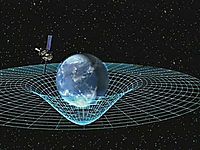
Photo from wikipedia
This study examined the isotopic composition of particulate bound mercury (PBM) in 10 Chinese megacities and explored the associated sources and transformation mechanisms. PBM in these cities was characterized by… Click to show full abstract
This study examined the isotopic composition of particulate bound mercury (PBM) in 10 Chinese megacities and explored the associated sources and transformation mechanisms. PBM in these cities was characterized by negative δ202Hg (mean: -2.00 to -0.78‰), slightly negative to highly positive Δ199Hg (mean: -0.04 to 0.47‰), and slightly positive Δ200Hg (mean: 0.02 to 0.06‰) values. The positive PBM Δ199Hg signatures were likely caused by physiochemical reactions in aerosols. The Δ199Hg/Δ201Hg ratio varied from 0.94 to 1.39 in the cities and increased with the increase in the corresponding mean Δ199HgPBM value. We speculate that, in addition to the photoreduction of oxidized Hg, other transformation mechanisms in aerosols (e.g., isotope exchange, complexation, and oxidation, which express nuclear volume effects) also shape the Δ199HgPBM signatures in the present study. These processes are likely enhanced in the presence of strong gas-particle partitioning of gaseous oxidized Hg (GOM) and elevated levels of redox active metals (e.g., Fe), halides, and elemental carbon. Based on Δ200HgPBM data presented in this and previous studies, we estimate that large proportions (∼47 ± 22%) of PBM were sourced from the oxidation of gaseous elemental Hg followed by the partitioning of GOM onto aerosols globally, indicating the transformation of Hg(0) to PBM as an important sink of atmospheric Hg(0).
Journal Title: Environmental science & technology
Year Published: 2022
Link to full text (if available)
Share on Social Media: Sign Up to like & get
recommendations!